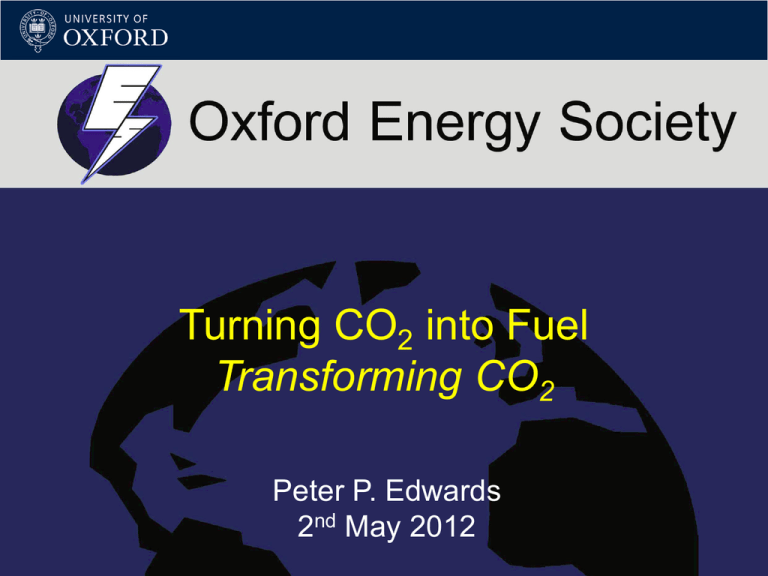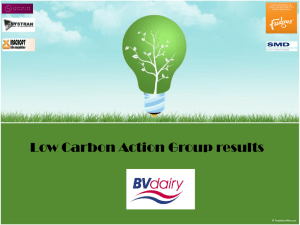CO 2 - Oxford Energy Society
advertisement

Turning CO2 into Fuel Transforming CO2 Peter P. Edwards 2nd May 2012 Transforming CO2 Z. Jiang, T. Xiao, V. L. Kuznetsov, L. Kong, P. J. Dobson R. J. Pearson, J.W.G. Turner , L. di Marco Tara Shirvani, Oliver Inderwildi, Sir David King Meeting our Energy Challenge “Fossil fuels will remain the dominant source of energy worldwide, meeting 83% of the increase in energy demands” Why is this? Ideal for transportation… Fuel energy densities: Net systems analysis Richard Pearson and Colleagues, Lotus Engineering CO2 Capture and Storage (CCS): The only option? The Natural Carbon Cycle: Fossil Solar Fuels G. A. Olah and colleagues, J.Am.Chem.Soc, 133, 12881-12898, 2011 A Possible Anthropogenic (Unnatural) Carbon Cycle G. A. Olah and colleagues, J.Am.Chem.Soc, 133, 12881-12898, 2011 Carbon Capture and Utilisation (CCU) The Concept of Carbon-Neutral Fuels Can we (sustainably) convert CO2 into liquid fuels? Should we convert CO2 into liquid fuels? Courtesy Lotus Engineering Carbon-Neutral Fuels The basic, underlying issue… …whether CO2 emissions due to energy consumption are larger than the amount of CO2 consumed in the process(es) … the universal issue of Life Cycle Analysis Carbon Capture and Utilisation (CCU) Carbon-Neutral Biofuels algae Liquid fuels dry or wet extraction T. Shirvani, X. Yan, O. R. Inderwildi, P. P. Edwards and D. A. King, Energy Environ. Sci., 2011, 4, 3773–3778 Anthropogenic Solar Fuels Royal Society of Chemistry CO2 is a ‘stable’ molecule Gibbs Free Energy of Formation 50.0 0.0 -50.0 NH3 (-16.6) O2 (0.0) C2H6 (-32.9) CH4 (-50.7) -150.0 CO (-137.15) -200.0 C8H18 (17.3) C10H22 (34.4) C3H8 (-23.5) CH3OH (-159.2) 0 ΔG (kJ/mol) -100.0 H2 (0.0) N2 (0.0) -250.0 H2O (-228.4) -300.0 -350.0 -400.0 -450.0 CO CO22 (-394.0) Z. Jiang, T. Xiao, V. L. Kuznetsov and P. P. Edwards, ‘Turning carbon dioxide into fuel’, Phil. Trans. R. Soc. A, 2010, 368, 3343-3364 Transforming CO2; Two main approaches 1. Use high chemical-energy starting materials 2. Supply high physical-energy; heat, light, electricity, solar Carbon-Neutral Fuels Methanol Renewable Hydrogen Energy in Carbon out Methanol synthesis Renewable hydrocarbons CO2 + 3H2 CH3OH + H2O Fuel use CO2 capture CH3OH+3/2O2 CO2+2H2O Carbon in CO2 from fossil fuel burning power plants Atmospheric CO2 Adapted from G.A. Olah, A. Goeppert, S.G.K. Prakash, J. Org. Chem. 74, 487-498 (2009) ‘Syngas’: Our Gateway to Fuels H C H CO2 + CH4 = 2CO + 2H2 H H Flue Gas CO2 to Fuel Chunshan Song (Penn State) The Catalyst CH4-CO2 “Reforming” on new Oxford catalyst in magnetofluidized bed SEM image of the Used Catalyst No carbon deposition Conversions CH4 CO2 Unpublished Results Turning CO2 into Fuel Biogenic CO2 Biomass refining CO2 Flue gas Fuel synthesis Air capture CO2 Fuel synthesis Energy Storage Via Carbon-Neutral Fuels Made From CO2, Water, and Renewable Energy, Special Issue of Proc. IEEE. R. J. Pearson, et al, 2011 Carbon-Neutral Fuels Courtesy Lotus Engineering Three possible pathways to ‘Low Carbon Energy’ Courtesy Lotus Engineering Transforming CO2 The Top 10 emerging technologies for 2012 6. Utilization of carbon dioxide as a resource Carbon is at the heart of all life on earth. Yet, managing carbon dioxide releases is one of the greatest social, political and economic challenges of our time. An emerging innovative approach to carbon dioxide management involves transforming it from a liability to a resource. Novel catalysts, based on nanostructured materials, can potentially transform carbon dioxide to high value hydrocarbons and other carbon-containing molecules, which could be used as new building blocks for the chemical industry as cleaner and more sustainable alternatives to petrochemicals. World Economic Forum, 2011, Abu Dhabi Reforming of (Bio) CO2 by (Bio) Methane Biogas Reforming Biomass Syngas F-T Sunlight-based fuel production Solar-energy collection and conversion







